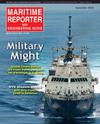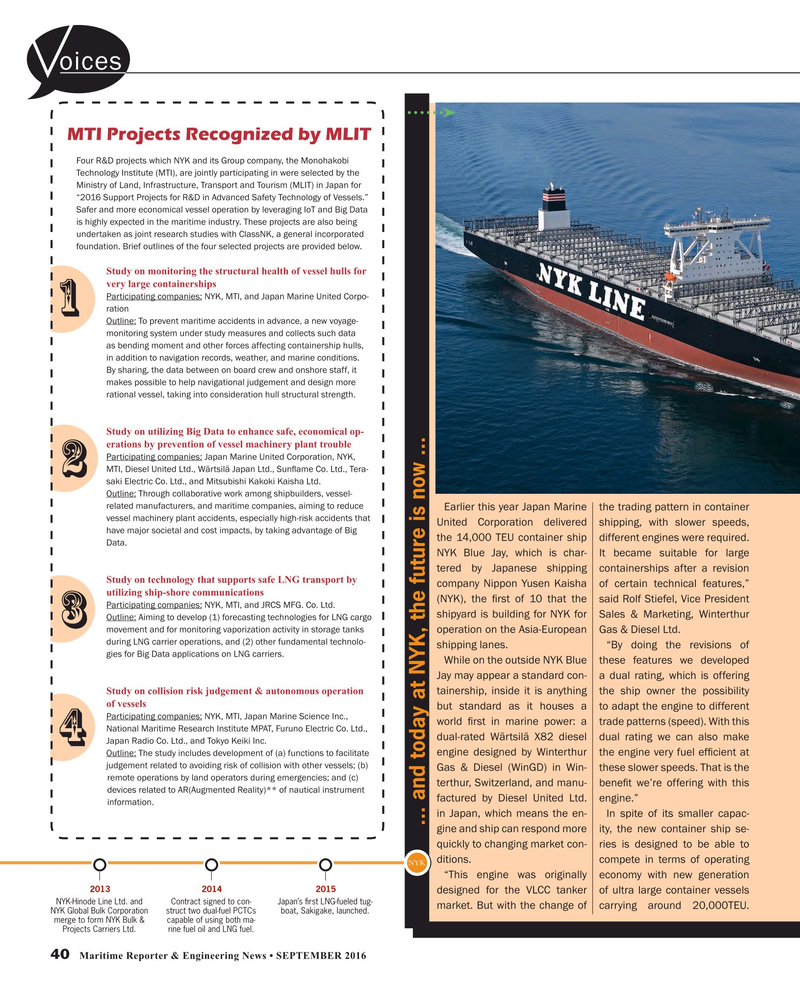
Page 40: of Maritime Reporter Magazine (September 2016)
Maritime & Ship Security
Read this page in Pdf, Flash or Html5 edition of September 2016 Maritime Reporter Magazine
oices
MTI Projects Recognized by MLIT
Four R&D projects which NYK and its Group company, the Monohakobi
Technology Institute (MTI), are jointly participating in were selected by the
Ministry of Land, Infrastructure, Transport and Tourism (MLIT) in Japan for “2016 Support Projects for R&D in Advanced Safety Technology of Vessels.”
Safer and more economical vessel operation by leveraging IoT and Big Data is highly expected in the maritime industry. These projects are also being undertaken as joint research studies with ClassNK, a general incorporated foundation. Brief outlines of the four selected projects are provided below.
Study on monitoring the structural health of vessel hulls for very large containerships
Participating companies: NYK, MTI, and Japan Marine United Corpo- 1 ration
Outline: To prevent maritime accidents in advance, a new voyage- monitoring system under study measures and collects such data as bending moment and other forces affecting containership hulls, in addition to navigation records, weather, and marine conditions.
By sharing, the data between on board crew and onshore staff, it makes possible to help navigational judgement and design more rational vessel, taking into consideration hull structural strength.
Study on utilizing Big Data to enhance safe, economical op- erations by prevention of vessel machinery plant trouble
Participating companies: Japan Marine United Corporation, NYK,
MTI, Diesel United Ltd., Wärtsilä Japan Ltd., Sun? ame Co. Ltd., Tera- 2 saki Electric Co. Ltd., and Mitsubishi Kakoki Kaisha Ltd.
Outline: Through collaborative work among shipbuilders, vessel- related manufacturers, and maritime companies, aiming to reduce
Earlier this year Japan Marine the trading pattern in container vessel machinery plant accidents, especially high-risk accidents that
United Corporation delivered shipping, with slower speeds, have major societal and cost impacts, by taking advantage of Big the 14,000 TEU container ship different engines were required.
Data.
NYK Blue Jay, which is char- It became suitable for large tered by Japanese shipping containerships after a revision
Study on technology that supports safe LNG transport by company Nippon Yusen Kaisha of certain technical features,” utilizing ship-shore communications (NYK), the ? rst of 10 that the said Rolf Stiefel, Vice President
Participating companies: NYK, MTI, and JRCS MFG. Co. Ltd.
shipyard is building for NYK for Sales & Marketing, Winterthur
Outline: Aiming to develop (1) forecasting technologies for LNG cargo 3 movement and for monitoring vaporization activity in storage tanks operation on the Asia-European Gas & Diesel Ltd. during LNG carrier operations, and (2) other fundamental technolo- shipping lanes. “By doing the revisions of gies for Big Data applications on LNG carriers.
While on the outside NYK Blue these features we developed
Jay may appear a standard con- a dual rating, which is offering
Study on collision risk judgement & autonomous operation tainership, inside it is anything the ship owner the possibility of vessels but standard as it houses a to adapt the engine to different
Participating companies: NYK, MTI, Japan Marine Science Inc., world ? rst in marine power: a trade patterns (speed). With this
National Maritime Research Institute MPAT, Furuno Electric Co. Ltd., dual-rated Wärtsilä X82 diesel dual rating we can also make 4
Japan Radio Co. Ltd., and Tokyo Keiki Inc.
engine designed by Winterthur the engine very fuel ef? cient at
Outline: The study includes development of (a) functions to facilitate judgement related to avoiding risk of collision with other vessels; (b)
Gas & Diesel (WinGD) in Win- these slower speeds. That is the remote operations by land operators during emergencies; and (c) terthur, Switzerland, and manu- bene? t we’re offering with this devices related to AR(Augmented Reality)** of nautical instrument factured by Diesel United Ltd. engine.” information.
in Japan, which means the en- In spite of its smaller capac- ... and today at NYK, the future is now ...
gine and ship can respond more ity, the new container ship se- quickly to changing market con- ries is designed to be able to ditions. compete in terms of operating
NYK “This engine was originally economy with new generation 2013 2014 2015 designed for the VLCC tanker of ultra large container vessels
NYK-Hinode Line Ltd. and Contract signed to con- Japan’s ? rst LNG-fueled tug- market. But with the change of carrying around 20,000TEU.
NYK Global Bulk Corporation struct two dual-fuel PCTCs boat, Sakigake, launched.
merge to form NYK Bulk & capable of using both ma-
Projects Carriers Ltd. rine fuel oil and LNG fuel.
40 Maritime Reporter & Engineering News • SEPTEMBER 2016
MR #9 (34-41).indd 40 9/2/2016 11:30:05 AM

 39
39

 41
41
